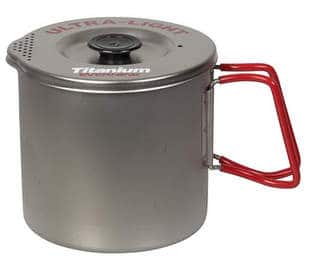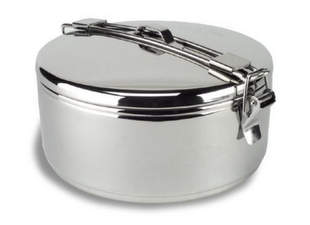Backpacking cook pots are available in titanium, aluminum, and stainless steel but there are significant differences in the cost, performance, and durability between them. What are the pros and cons of each material and other factors that you should consider when choosing a backpacking and camping cook pot?
Titanium Backpacking Pots
Titanium cook pots are the best choice if your top priority is saving weight. But titanium backpacking pots are more expensive than aluminum or stainless steel pots and are best used for boiling water to rehydrate food rather than cooking or frying more complex meals.
- Pros
- Ultralight-weight
- Stronger than steel or aluminum
- Corrosion-resistant
- Cools quickly, so you can use your cookpot as a multi-purpose bowl or mug
- Cons
- Heats unevenly, so not good for slow cooking or frying
- Most expensive
Look for models with folding handles and colander or pressure relief holes in the lid to help prevent messy boilovers like the Evernew 1L Titanium Pasta Pot (4.1 oz), Toaks 650ml Titanium Pot (2.8 oz) or Toaks Titanium 500ml Pot (2.6 oz).
Aluminum Backpacking Pots
Aluminum cook pots strike a good balance between low-cost and lightweight. They retain heat well and cook evenly, making them ideal for more complex meals and group meals. While you can use them to boil water for simple meals, they take longer to cool than titanium and are more difficult to eat or sip from if you’re in a rush. Most aluminum cook pots are hard anodized (HA). This process makes aluminum more durable and corrosion-resistant. This is important for backpacking when you’re likely to pack a wet or damp cook pot. Some aluminum frying pans and cook pots also come with non-stick surfaces, which makes sense if you plan on cooking real food like bacon, eggs, or pancakes, although the non-stick surface will eventually wear out if they’re heavily used or abused.
- Pros
- Lightweight
- Less expensive than titanium
- Heats evenly, so it’s good for cooking more complex meals and group cooking
- Hard anodized aluminum pots are corrosion-resistant
- Non-stick pots are available
- Cons
- Takes longer to cool
- Not as light as titanium
Look for models with sturdy handles and locking lids like the GSI Halulite 1.1L Boiler (HA, 8.6 oz) or the MSR Ceramic 2.5L Pot (Non-stick, 10.1 oz) when cooking for a couple or group. You can also buy a non-anodized 0.7L IMUSA aluminum mug (2.4 oz) and make a lid for it out of a pie tin. But it’s pretty thin aluminum and will dent easily.
Stainless Steel Backpacking Pots
Stainless Steel backpacking and camping pots are the workhorses of the backcountry. They’re ideal for people who are very hard on their gear, including guides, scout groups, and outdoor organizations. Performance-wise, stainless steel pots are more heat efficient than titanium pots, but not as easy to cook with as aluminum. Stainless steel pots are also heavier than both titanium and aluminum pots but are by far the toughest choice and the most affordable.
- Pros
- Super durable. Lasts forever
- Least expensive
- Cons
- Subject to hot spots like titanium.
- Not as light as titanium
Look for pots with sturdy long, locking handles that let you store your stove and cooking supplies inside like the 1.6L MSR Alpine Stowaway Pot (19.5oz), which is available in several smaller sizes. Hanging kits like GSI Outdoor Stainless Troop Cookset are also good when cooking over campfires.
Additional Selection Tips
Here are some additional features and tips to consider when selecting a backpacking cookpot or camping cookware.
- If you plan to measure liquid, get a pot that has liquid quantity markings scored in ounces and ml.
- If you plan on boiling water and pouring it into a cook-in-the-pouch freeze-dried or dehydrated meal, get a pot that has a pour spout.
- Most commercially prepared backpacking meals need 2 cups of water or 473 ml. When sizing a pot, don’t forget that your food will displace some water if you cook food inside the pot, and don’t just boil water with it.
- If you buy a titanium cookpot, make sure the pot lid is made of titanium and not steel.
- Avoid pots that don’t have fold-away handles and require the use of a pot gripper. The grippers are easy to lose or forget.
- The Halulite pots made by GSI Outdoors are hard anodized. Halulite is their confusing way of branding a hard anodization process.
- If you cook with gas, make sure the cookpot you choose can hold a small or medium-sized gas canister and your stove when packed.
- If you use a windscreen when cooking, get one made of titanium foil that will roll up inside your pot when packed.
- Most integrated cook systems like those from Jetboil (Flash, Zip, etc) and the MSR Windburner come with hard-anodized aluminum pots.
- Wide pots capture more stove heat than narrow pots.
See also:
SectionHiker is reader-supported. We only make money if you purchase a product through our affiliate links. Help us continue to test and write unsponsored and independent gear reviews, beginner FAQs, and free hiking guides.



